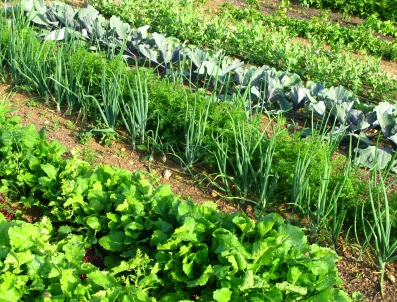
In the last few years, organic vegetables have been among the bestselling commodities in supermarkets across the country. Consumers are aware that organically grown vegetables have much higher nutritional values than ordinary produce traditionally grown using all sorts of fertilizers and artificial chemicals. Organic vegetables are certainly better for our health, but they tend to be heavier on the budget.
To ensure your family stays healthy without having to buy expensive organic vegetables, why not grow your own vegetables? You can start a vegetable garden right in your backyard. If you have experience in maintaining a flower garden, you shouldn’t have too much trouble starting and growing a vegetable garden. Vegetables are generally a lot easier to care for than flowers because most of them thrive regardless of the season. Vegetables also take up less space to grow.
Vegetable Garden Layout
A typical layout for a vegetable garden consists of several rows, with each row dedicated to a particular vegetable. Most vegetable gardeners like planting different vegetables on alternate rows so they will always have something to harvest regardless of the season.
Another common vegetable garden layout is one that makes use of beds instead of rows. This layout is more suitable if you have a limited amount of open space in your backyard. Make sure your beds are small enough that you can still easily weed your garden even when your vegetables have started to grow. It is also a good idea to elevate the beds slightly to keep the roots from getting drowned and to keep the heat sealed in during the cold seasons.
If you don’t have a backyard or any open ground for planting, you can still start a vegetable garden by growing seeds in plant boxes, cans, jars, or any other container you can get your hands on. You can still harvest your own vegetables even if you live in high-rise apartment in the middle of the city. Just make sure to place your vegetable containers in an area that gets plenty of sunlight, like the balcony.
Preparing the Soil
Soil preparation is one of the most important parts of vegetable gardening. The type of soil you choose essentially determines the quality of the vegetables you will harvest so it is important that you take extra care during this process. The best type of soil to use for vegetable gardening is a mixture of 20% clay, 40% sand, and 40% silt. This soil combination is perfect for retaining and absorbing water while allowing the roots to breathe easily. One way to determine if you have good soil is to make a ball out of it with your hand. The ball should be firm enough to hold its shape yet soft enough to crumble when you prod it with your finger.
After preparing the soil, you can now shop for seeds and start growing your own vegetables. It may take up to several weeks or even months before you can harvest your first batch of vegetables, but as most vegetable gardeners will tell you, the wait is definitely worth it.

